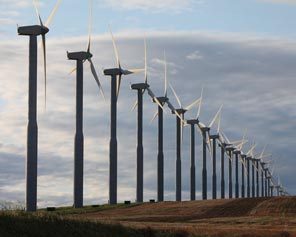forum
library
tutorial
contact

Wind-Power Producers Fight
Possible Shutdown of Turbines
by Hal BerntonThe Spokesman-Review, April 10, 2011
|
the film forum library tutorial contact |

|
Wind-Power Producers Fight
by Hal Bernton |
 PORTLAND -- Pacific Northwest wind-power producers are battling a proposal that could force them to periodically shut down their plants in the months ahead, potentially costing them millions of dollars in lost revenue.
PORTLAND -- Pacific Northwest wind-power producers are battling a proposal that could force them to periodically shut down their plants in the months ahead, potentially costing them millions of dollars in lost revenue.
Bonneville Power Administration (BPA) officials say that limiting wind production could be required to free up space in the regional transmission system to handle hydropower generated from the melt-off of a huge mountain snowpack this year.
"We're looking at doing everything we can to avoid the shutdowns but you have to be able to do something when your back is against the wall," said Doug Johnson, a BPA spokesman.
But turbine owners bristle at the BPA proposal, which they say would result in a big financial hit during the blustery spring and early summer months, peak season for wind generation.
"There has been a strong united [wind industry] voice saying 'this is not reasonable,' " says Roby Roberts, a vice president of Horizon Wind Energy, which has built wind farms in Oregon and the Kittitas Valley in Washington.
The dispute reflects major strains on the regional power system, which has been reshaped by a dramatic expansion of wind power in Washington and Oregon. Most of that power is exported to California and other markets outside the Northwest.
Wind-power producers say the BPA should compensate them financially for any prolonged shutdowns ordered by the agency. Their ranks include Puget Sound Energy, which has built wind farms in Washington.
BPA officials say the shutdowns will only happen as a last resort and that wind producers should not receive compensation.
Such payments would raise operating costs and could push up rates for the BPA's major customers -- Northwest public utilities, including Seattle City Light, which have endorsed the agency plan.
"We think that is not a fair transfer of costs and puts too much of a burden on public-utility ratepayers," said Doug Johnson, a BPA spokesman.
During the past decade, wind power has attracted billions of dollars of investment, driven in part by tax incentives and state requirements that utilities buy renewable energy other than hydro power.
When the winds are fierce, the Northwest farms are capable of producing up to 3,500 megawatts of power. That's more than triple the energy of the Northwest's sole nuclear-power plant.
Total wind-power capacity could double by 2015.
The BPA manages the regional power-supply system by balancing, minute by minute, the flow of electricity surging through the system with demand.
As the wind industry expands, the BPA has found it more difficult to transmit all that power and still meet other responsibilities, which include selling hydro power outside the region and spilling water over dams to aid the passage of migrating salmon.
Last June, the BPA balancing effort turned into a high-wire act as a late snow melt unleashed a gusher of water down the Columbia River at the same time that winds whipped up the power turbines.
BPA officials said that they couldn't divert all the water around the hydroelectric turbines without putting too much dissolved gas into the river and placing salmon at risk. So they ended up running more water through the dam turbines and giving away their surplus power to utilities all over the West.
That spurred the agency to develop a new proposal to periodically shut down wind-power farms to help balance loads. The plan was embraced by public utilities across the region.
"Bonneville is doing the best they can to try to make this work for all parties, and we support this effort, said Steve Kern, of Seattle City Light. But the draft plan released earlier this year triggered a backlash from wind-power operators and their congressional allies.
For many wind-power producers, a big part of the payback is collecting tax credits for power production. Those credits couldn't be collected during shutdowns.
They are pressing for alternatives to ship their power to other areas of the U.S. and Canada, and more flexibility to substitute wind power for fossil fuel-generated electricity outside the region, according to Robert Kahn, who represents many of the region's major wind-farm operators.
But those are all long-range efforts.
In a March 31 letter to the BPA, Sen. Jeff Merkley and Rep. Earl Blumenauer, of Oregon, wrote that the agency proposal could result in "significant economic harm" to wind-power projects and threaten future development.
The pressure appears to have slowed down BPA. The final plan was supposed to be released by April 1 but has now been delayed.
In the years ahead, the BPA will try to develop new options for balancing the system, such as diverting surplus river water inland to help recharge aquifers.
learn more on topics covered in the film
see the video
read the script
learn the songs
discussion forum
